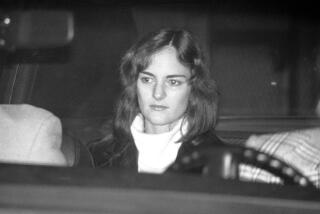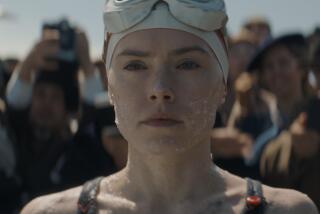Propelled by Earhart’s Soaring Spirit
- Share via
Aviatrix Amelia Earhart was the greatest role model of my life. Born in 1897 in Atchison, Kan., Earhart was the first woman to cross the Atlantic by air, though she was little more than a passenger on the 1928 trip. In 1932, however, she flew the Atlantic solo in her small Lockheed Vega, reproducing the 1927 Atlantic crossing of Charles Lindbergh in his famous “Spirit of St. Louis.”
Earhart became one of the first pilots to experiment with the autogiro, or helicopter, and she tirelessly promoted the development of national commercial-airline passenger service. In 1935, she made the first solo flight from Hawaii to California. In one of history’s great mysteries, she and a male co-pilot disappeared over the Pacific on the last leg of a record-breaking round-the-world flight.
An eloquent spokeswoman for women’s rights in the decades following American women winning the right to vote in 1920, Earhart was a prominent lecturer and writer as well as an instantly recognizable figure in the new media of picture magazines and newsreels. Like Marlene Dietrich and Katharine Hepburn, she helped popularize casual slacks for women. Earhart’s sporty, long-legged look was instrumental in redefining the modern female image.
I first encountered Earhart in 1961 via an article in the Syracuse Herald Journal about the discovery on the island of Saipan of bones that were rumored to be hers. (The theory later proved false.) The newspaper’s dashing photograph of Earhart electrified me: She was heroic yet graceful, a persona utterly unlike that of the perky, sugary blonds then dominating the American cultural scene--especially Doris Day and Debbie Reynolds, who were making my life miserable.
As a loud, lurching 14-year-old Italian-American tomboy, I was hopelessly out of sync with contemporary teenage values, which centered on dating, sororities and proms. Most girls wanted to look pretty, go steady and get married. Few had my kind of driving ambition and lust for achievement, which I expressed through a passion for swords, medieval armor and Napoleonic military uniforms.
Then virtually forgotten, Earhart embodied a dramatic boldness I found nowhere in the conformist females of the late 1950s and 1960s. Curious, I tracked down a library copy of her autobiographical memoir, “The Fun of It,” and promptly fell under the spell of her charming, forthright personality. Earhart had both pluck and poetry, with a feeling for the beauty as well as the mechanics of flying.
Bitten by the Earhart bug, I would spend the next three years obsessively researching her. It was the first independent scholarly project I ever undertook, and it taught me sleuthing strategies that later served me well in my career as a teacher and writer.
Dissatisfied with the available books on Earhart, I proceeded to plow systematically through newspapers and magazines of the period, most of which were not yet transferred to microfilm. It took me months, for example, to go through the New York Times and other physically decaying newspapers from 1928 to date.
At the Syracuse University Library and the beaux-arts Carnegie Public Library downtown, I became so familiar a figure that the librarians granted me stacks rights just to get rid of me. I was a real pest: The staff got plumb tired of lugging out the heavy volumes of old sooty periodicals that I requested on endless call slips.
My letters of inquiry about Earhart, sent to individuals and institutions around the world, eventually numbered 261. On side trips from family vacations, I visited Earhart’s Kansas birthplace and the small airfield near Miami where she left the U.S. on her last flight. I met her sister near Boston and enjoyed a private screening of Earhart newsreels at the headquarters of Movietonews in New York City.
The curator of the National Air Museum at the Smithsonian Institution in Washington, D.C., very graciously met with me and brought out of vault storage a box of Earhart’s medals and decorations for my awed inspection. At Indiana’s Purdue University, to which her husband, publisher George Palmer Putnam, had bequeathed her archives, I sorted through Earhart’s letters and other effects and even tried on one of her leather jackets for size.
At 16, I gave my first public speech when I was guest of honor at the annual Amelia Earhart Banquet of the Zonta Club (a national women’s group co-founded by Earhart) in upstate New York. My first feminist protest letter was published in both Newsweek and Life magazines in 1963. Invoking “Earhart’s lifelong fight for equal opportunity for American women,” I assailed the fact that the Soviet Union had put a woman (Valentina Tereshkova) into orbit before the U.S., which still barred women from the space program.
Earhart was a huge inspiration for me. She pulled me out of my tailspin as an alienated adolescent and social misfit. My Earhart project gave me a sense of mission, and it sharpened my historical sense and honed my research skills.
As a feminist, Earhart never blamed men for women’s problems. On the contrary, she simply wanted to prove that women could achieve the very highest standards set by men. I still deeply admire her disciplined code of personal responsibility and self-reliance. She was the original model for my philosophy of equity feminism, which demands equal opportunities but not special protections for women.
Some revisionist historians have bizarrely tried to credit Earhart’s pioneering activities to her publicity-minded husband. But it was Amelia Earhart herself who took to the air and who pitted her safety and eventually her life against the unforgiving forces of nature.
More to Read
Sign up for The Wild
We’ll help you find the best places to hike, bike and run, as well as the perfect silent spots for meditation and yoga.
You may occasionally receive promotional content from the Los Angeles Times.






